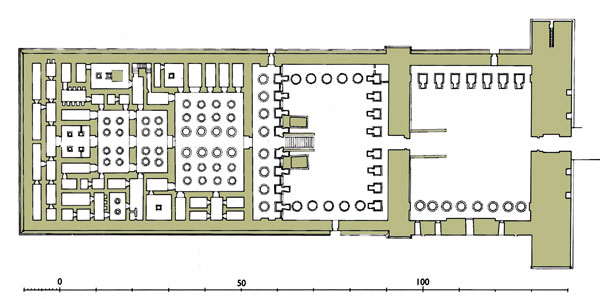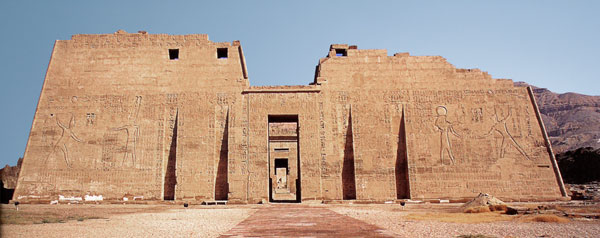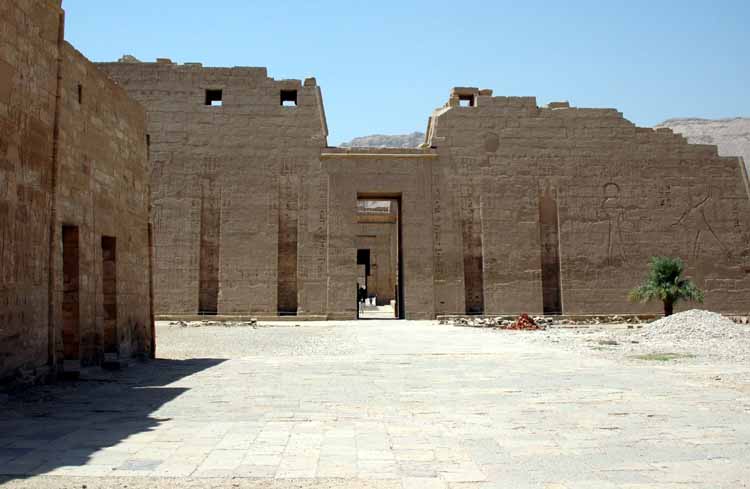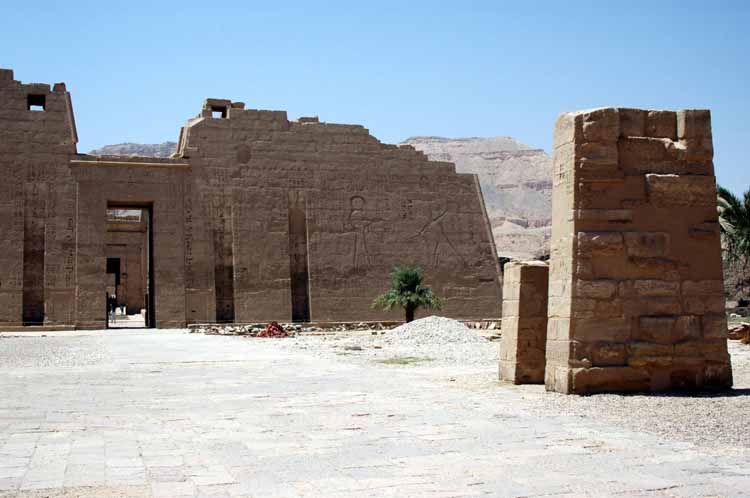- The Temple of Ramesses III
The Temple of Ramesses III is the best preserved among all temples of Thebes, and its decorated surfaces amount
to 7,000 square meters. The structure of the Temple and its iconographic system are similar to those of the
Ramesseum, although it can hardly equal the elegance of its forms and the balance of dimensions. A unique feature of
this Temple, that used to be called in ancient times "the Temple of User-Maat-Re Meriamun who Joins Eternity in the
Possession of Amun in the West of Thebes", is the presence on its eastern side, in front of the first pylon, of a
tower built in the form of a Migdol (a military fortress in Asia Minor) which gave the Temple the aspect of a
fortress and had protective functions in the large wall surrounding the Temple. On passing through the Migdol, one
enters a vast space preceding the first pylon where, to the left, one can see the funeral chapels of the Divine
Adoratrices of Amun and, to the right, the Temple of Amun of the 18th Dynasty. The external lateral walls of the
Temple are covered with important bas-reliefs; of particular interest among them are those of the northern wall
illustrating the battles fought by Ramesses III against the Peoples of the Sea. On the southern wall, numerous
liturgical festivities are listed and reproduced, as well as the economic resources of the Temple necessary for its
complex functioning and brought there from its numerous possessions donated to the Temple by the king at the time of
its inauguration.
-
 - The first pylon, on which one can see four large hollows intended to hold wooden poles from
which flew the divine insignia, is decorated with bas-reliefs showing Ramesses III in the process of ritual massacre of
Asian prisoners in front of Amun-Re (the southern tower) and Nubian and Libyan prisoners in front of Amun-Re-Harakhty
(the northern tower). On the south-western side of the pylon, one can see a brilliantly illustrated scene of
bull-hunting in the marshes; it is considered one of the artistic masterpieces of the 20th Dynasty. Having passed
through the gigantic door of the first pylon, one enters the first courtyard, on whose northern and southern sides are
two porticos; the southern portico has an opening, the so-called "Window of Appearances" connected to the royal palace
situated outside. The dominant theme of the bas-reliefs in the first courtyard is represented by the king's troops
annihilating the enemy (the Libyans and the Peoples of the Sea) whom Ramesses fought during the 8th year of his reign.
On the walls are shown not only the vanquished enemies, who can be recognized by an exhibition of parts of their bodies,
but also the war booty, duly listed and quantified, together with the hands and sometimes the phalluses which the
Pharaoh's soldiers used to cut off the dead bodies to 'count' their victories and be rewarded.
 -
- The first courtyard is closed on the north by the second pylon, whose door leading to the
second courtyard. The second courtyard which was also referred to as the "Courtyard of the Feasts" is surrounded by
a peristyle: both porticos on the eastern and western sides are decorated with eight Osirian columns, while those to
the north and south are supported by large columns in the form of papyrus scrolls.
-
- At first, the decoration motifs continue the military themes characteristic of the
preceding courtyard (the eastern part of the southern portico) but, farther on, there are illustrations of great
religious festivities dedicated to Sokar-Osiris (southern portico) and to Min (northern portico). The wall of the
western portico, from which a staircase leads to the first hypostyle hall, is dedicated to the theme of royal power:
in the northern part, the king is being purified by Thoth and Horus, and, in the southern part, one can see the
scene representing the Pharaoh's accession to the throne where he is accompanied by Thoth in front of the Triad of
Thebes. This wall also features the pictures of the sons of Ramesses III, the future Ramesses IV, VI, VII, and VIII,
whose images were added in succession as these princes acceded to the throne.
-
- The first hypostyle hall, of which only the base of the 24 columns that supported the
ceiling now remain, has in its south-western part a complex of four rooms, evidently intended to serve as treasury
for the Temple, as is proved by bas-reliefs on the walls representing heaps of gold, silver and precious stones. Two
more annexes situated in the corner between the first and the second hypostyle halls were intended to serve as sites
for the cult of the god Montu (the first) and as an additional treasury (the second). The northern side of the
hypostyle hall contained a group of five contiguous halls, perpendicular to the axis of the Temple and dedicated to
various divinities. Moving towards the West, one enters the second hypostyle hall supported by eight columns, with
two groups of lateral halls annexed: those situated in the southern part were dedicated to the Osiris cult of the
deified king, while those in the north were dedicated to various solar gods, among whom the dominant role belonged
to Re-Harakhty with whom the king was identified in his celestial resurrection.
Then follows the third hypostyle hall whose structure is identical to the previous one and whose lateral chapels are
dedicated to various gods: Horus and Mut in the south, Amun-Re, the Ennead of Heliopolis, Min, Mut, and Khonsu in
the north. | |


